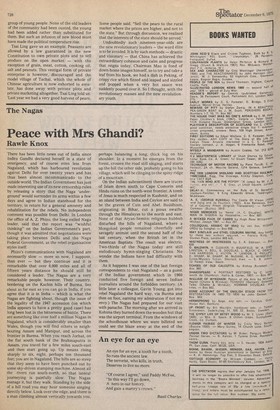The Nagas
Peace with Mrs Ghandi?
Rawle Knox
There has been little news out of India since Indira Gandhi declared herself in a state of emergency, and of course even less from Nagaland, which has harboured revolution against Delhi for over twenty years and has thus been almost incommunicado to the outside world. The Indian Government has just made interesting use of its new censorship rules by releasing a story that the Naga 'underground' would surrender its arms within a few days and agree to Indian statehood for the territory, in return for a general amnesty and rehabilitation for the rebels. No independent comment was possible from Delhi. In London the office of A. Z. Phizo, the long exiled Naga leader, said that the report was "wishful thinking" on the Indian Government's part, though it was admitted that negotiations were taking place between Delhi and the Naga Federal Government, as the rebel organisation styles itself.
Phizo's communications with Nagaland are necessarily slow — more so now, I suppose. than ever — but they continue and it is remarkable that over 6,000 miles and all of fifteen years distance he should still be considered a leader. The Nagas are a very remarkable people, however. Their country, bordering on the Kachin hills of Burma, lies about as far east as you can go in India, if you agree that it is in India — which is what the Nagas are fighting about, though the issue of the legality of the 1947 accession (on which India appears to have a pretty good case) has long been lost in the bitterness of battle. There are something like over half a million Nagas in Nagaland, which is considerably smaller than Wales, though you will find others in neighbouring Assam and Manipur, and across the frontier in Burma. When you reach Jorhat, on the flat south bank of the Brahmaputra in Assam, you travel for a few miles south-east and then start going up. Up means rising sharply to six, eight, perhaps ten thousand feet; you are in Nagaland. The hills are so steep that they seem to have been punched out by some sky-driven stamping machine. Almost all the rivers run south-north, so that lateral journeying is painfully slow. The Nagas manage it, but they walk. Standing by the side of a hill road you may hear someone singing directly below. Look over the edge, and there is a man climbing almost vertically towards you, perhaps balancing a long, thick log on his shoulder. In a moment he emerges from the forest, crosses the road still singing, and starts up the hill the other side, probably going to his village, which will be clinging to the spiny ridge of a mountain.
On the Indian subcontinent there are traces of Islam down south to Cape Comorin and Hindu ruins on the north-west frontier. A tomb of Jesus is much respected in Kashmir, and on an island between India and Ceylon are said to be the graves of Cain and Abel. Buddhism, originating in Bihar, cut a pious swathe through the Himalayas to the north and east. None of that Aryan-Semitic religious hubbub disturbed the hills of Nagaland, where a Mongoloid people remained cheerfully and savagely animist until the second half of the last century, when the British let in the American Baptists. The result was electric. Two-thirds of the Nagas today are still melodiously hymn-singing Christians. No wonder the Indians have had difficulty with them.
As it happens I was one of the last foreign correspondents to visit Nagaland — as a guest of the Indian government which in 1960 conducted five foreign and seven Indian journalists around the forbidden territory. (A little later a colleague, Gavin Young, got into rebel Nagaland the hard way, via Burma and then on foot, earning my admiration if not my envy.) The Nagas had prepared for our visit with panache. The morning after we arrived in Kohirna they burned down the wooden hut that was the airport terminal. From the windows of the schoolhouse where we were billeted we could see the blaze away at the end of the
valley. And when I went outside in search of a v■rash-place I found the guard huddled behind it While a few desultory bullets whapped into the wooden walls. Wherever we went, even when our conductors suddenly changed the itinerary, uninvited guests leaped up at the end of a Planned ceremony and made speeches for Naga independence. At one halt, in a small and 'good' Village, we were to be presented with woven Naga bags and in turn approached a pretty srmling girl who slipped the carrying band over One's head and to the shoulders. A news agency man suddenly found himself sagging with the weight of his Naga bag, and later withdrew from it an enormous brief on alleged Indian army atrocities in Nagaland, with signed statements and photographs, and a request that It be forwarded to the United Nations. The evening before we left we were at a large village outside Mokokchung. There was the usual hymnal procession to the church, followed by the usual firelit tribal war dance. The Indian Special Commissioner made a speech. From among the dancers a tall Naga with a spear came out into the full firelight. He started with conventional words of welcome, but then the tone changed, and as each sentence ended he flung the spear into the ground before him and plucked it loose before starting again. The interpreter's tone changed too, and it appeared, through him, that the Naga had launched into a rigmarole of praise for India's current five-year Plan. A voice whispered fiercely in my ear: "He IS telling lies. I will interpret for you." Yet for all the brilliant Naga improvisation, I was struck ,rnost by a sight in the Tuensang division when I had managed to wander off on my own. It asn't easy to get away from one's hosts, but th.e Nagas of Tuensang have had less contact With the west — even the missionaries didn't rPenetrate deeply there — and were thought less lkelY to nobble us. I was looking around a small thatched ed Naga shrine, where human skulls, .victirns of headhunting raids of long ago, still rliing from the roof. There was a sort of circular, counter in the centre on which were wooden carvings of figures who represented, or so my Casually acquired Naga guide told me, vanTlished enemies. Among them, quite unmistaKa*, was a rudely shaped aeroplane. I didn't ask him about that, since the Naga rebels had Shot down an Indian Air Force plane and the crew were then still prisoners. I wonder if they really have made peace. Of tnne thing I am sure: if the Indians permitted h „,..ese highly intelligent people to have more ,-'ritact with the outside world, instead of locking themselves and the Nagas into a sort of rnpressed enmity chamber, there would be a r healthier chance of settlement. Independent stagaland is a nonsense for the Nagas and a r rategic impossibility for India, but no Naga ,ebel is going to let an Indian tell him so. avui tside opinion isn't always emotional, doesn't d WaYs mean encouragement for the under 0g. Mediators aren't the only answer to local wars. Sometimes a breath of fresh air will do Wonders for combatants who haven't smelled r_he stuff for years, whether they be in Iviokokchung — or Belfast.


































 Previous page
Previous page